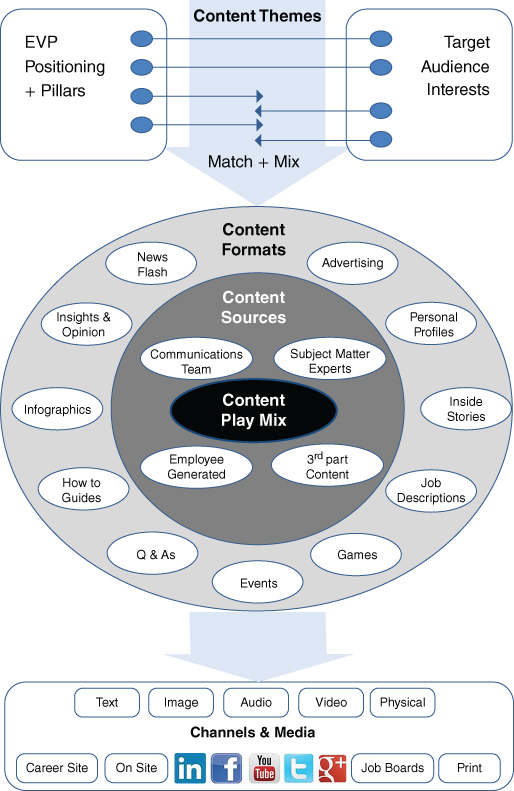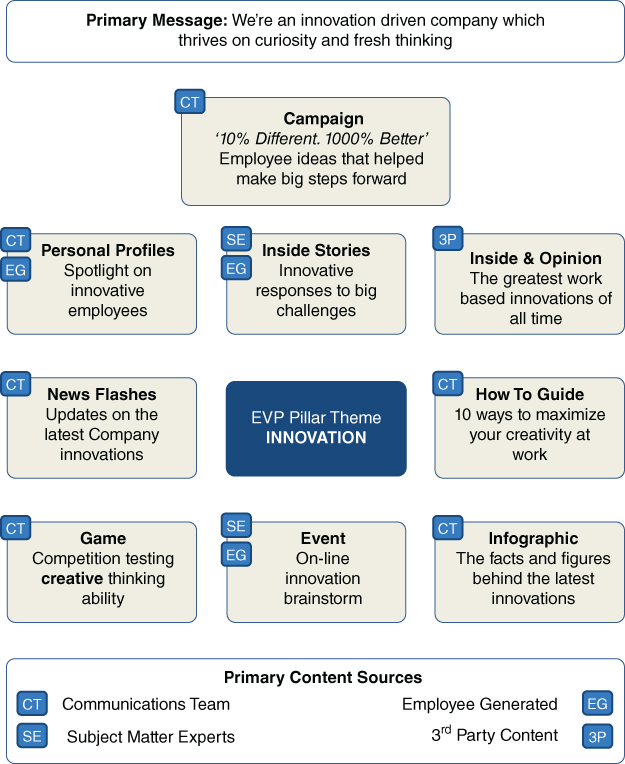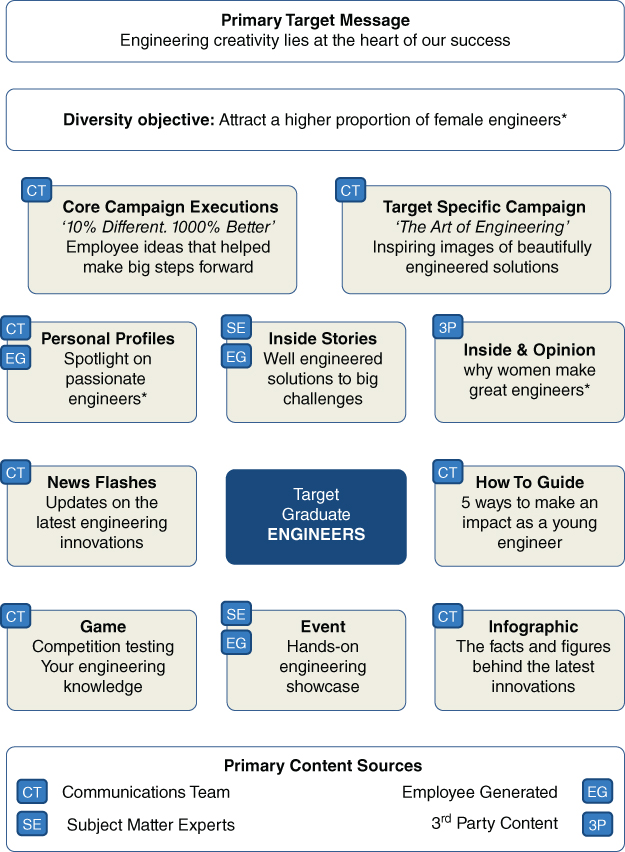Chapter 16
Communication and Content Planning
‘So here's the plan. We crawl onto the shore, struggle over the rocks, learn to breathe, haul ourselves upright on our fins, learn to walk, head inland and build cities. Who's with me?’
Steve Way
Your EVP may be deeply rooted in organizational strategy, or it may simply be a means of summarizing your key recruitment communication themes. Either way, it should provide the platform for your communication and content strategy. The two most basic objectives of any communication strategy are to engage your target audience, and get your message across. The additional objective from an employer brand perspective is to ensure that the collective result of your communication is a more positive and distinctive brand image. This objective may partly be served by ensuring your communication content is consistently branded and framed, but ideally it should also mean that the content itself helps to reinforce consistent brand associations. For example, a series of employee focused stories may engage the target audience. It may help to personalize the corporation, making it more attractive to graduates. It may also serve to prompt an application. All of these are worthy communication objectives. However, it will fall short of effective brand communication if it doesn't also demonstrate and dramatize the key characteristics of the organization you want potential candidates to associate with you. We like the fact that Larry's story reveals a great personality, and that he loves his job. We like it even more when Larry's story involves innovation or career mobility or great cross-functional teamwork (if these happen to be your primary EVP themes).
There is a danger of this sounding like obsessive compulsive brand control, where every message and piece of content must align with a brand pillar, in the same way the brand identity should. This would not be at all healthy. It should be noted that the objective is to ensure that there is enough consistency in the overall content mix to make sure the desired employer brand associations are communicated, not each and every communication. You can visualize this in terms of three levels of content as follows (Figure 16.1).

Figure 16.1 Marketing content categories.
Making the assumption that you have identified 3–5 EVP pillars or core communication themes, I suggest taking the following steps in setting out a communication and content strategy.
STEP 1: TARGET DEFINITION AND INSIGHTS
You should be clear about your overall target definition and key target segments (see Chapters 6 and 7 for more detail). While this should include your knowledge or assumptions about the media preferences of each target group, we are assuming here that you will need to cover most of the broad media types covered in Chapter 14.
STEP 2: OVERARCHING COMMUNICATION OBJECTIVES
Before you set out your communications strategy and content plan you should be clear about your primary objectives. These can usually be divided into internal and external goals.
Internally, these could include:
- Establishing awareness of your employer brand promise.
- Supporting the roll-out of a new corporate brand/mission and values.
- Clarifying the consequences of organizational change to the employment ‘deal’.
- Improving levels of employee engagement and retention.
- Driving higher levels of proactive advocacy and referral.
Externally, your objectives could include:
- Raising overall awareness of your employer brand.
- Refreshing and reinforcing existing brand perceptions.
- Addressing misperceptions.
- Driving for higher quality or higher volume recruitment.
While many of these goals could be relevant at the same time, it is important that you create some form of prioritization to ensure you are targeting your investments effectively. It's also important to clarify the relative importance of different target groups. Internally, this may include areas of low engagement and high attrition. Externally, this would typically include the relative emphasis (and investment in) graduates vs experienced hires, or particularly hard to recruit segments like engineers or high quality sales people.
STEP 3: MESSAGE HIERARCHY
A well-defined EVP should make it very clear what you want people to associate with you as an employer, but it can also be helpful to develop a more detailed framework of potential messages and claims. This serves a number of objectives.
- It creates a centrally agreed list of credible claims. An EVP pillar that focuses on providing rich opportunities to learn could be translated into: ‘Plentiful learning opportunities’, ‘World-class learning opportunities’ or ‘Cutting edge learning opportunities’. A messaging framework can provide guidance on which level of claim the employer brand team feels to be credible, and the point at which the message becomes an over-claim.
- It helps to keep the communication fresh, by providing a variety of different ways of getting the central message across.
- It provides a richer palette of potential messages for different target groups.
For example, the primary message underpinning the LEGO Group EVP pillar ‘Clutch Power’ is:
TLG is a highly collaborative organisation with a strong sense of community.
Desired takeout: I will be supported by my colleagues and feel a strong sense of belonging.
This is supported by six secondary messages, as follows:
-
The Lego Group is a closely inter-connected global company where you're likely to work alongside people from many different parts of the world.
Desired takeout: This is a company which will expand my horizons.
-
We work freely across organizational boundaries.
Desired takeout: I'm less likely to come across the ‘silo mentality’ you tend to find in large organizations.
-
We encourage people to develop a wide personal network within the organization.
Desired takeout: This is the kind of company where personal connections count.
-
The Lego Group is a relatively informal company with an open and accessible approach to management.
Desired takeout: This is a non-hierarchical company where I'm likely to develop a close working relationship with people regardless of their position.
-
We encourage people to be themselves, and speak their minds.
Desired takeout: This is a company where I will be able to express myself.
-
We don't put people in boxes.
Desired takeout: This is a company that will allow me to develop beyond my immediate area of expertise.
STEP 4: SOURCING CONTENT
Before you create your publishing plan, it's important to identify where you will be drawing your content from. This is one of the biggest challenges if you are setting out from scratch as most organizations tend not to have collected and curated content in this way. Sources can be divided into four main categories.
-
Communications team
This is where the level 1 brand promises are created either in-house or with the support of external communication agencies. It should also provide the source for other corporate brand related content that may be relevant to the employer brand. If the organization has some form of communications network, this will also provide a link to local sources.
-
Subject matter experts
This will include most members of the senior team, functional heads and specialists in a range of fields that either wish to communicate their policies and plans or have content that may be of interest to specific target populations.
-
Employee generated content
This is becoming an increasingly rich source of content in many organizations as systems and processes are put in place to stimulate and collect employee stories and opinions on a range of subjects that will be of interest to both current and potential employees. (See Chapter 17 for more detail.)
-
Third-party content
As discussed in the previous chapter, the organization can also draw on external sources of content that may be of interest to target audiences and help to hook them into engaging with the level 1 and 2 brand content on the careers website or job pages.
Content audit
Before putting your plan together, it's important to evaluate how much and what kind of relevant content already exists. The content audit should aim to identify:
- Content you've already published that could be re-channelled (for example, video content on your career site that could be re-published on your YouTube channel, or stories that have appeared in your in-house magazine that could be re-channelled to LinkedIn or Facebook).
- Content you have immediately available to publish, for example existing photo archives.
- Content that may exist locally or in other functions (like marketing) that could be re-edited and re-purposed for employer brand marketing.
- Areas of expertise that align with target audience interests that you've yet to tap into.
If you have a large quantity of existing content and want to conduct a more comprehensive audit, I suggest you buy a copy of Content Strategy For The Web1 which provides an excellent framework for this kind of assessment.
Once you've conducted this audit of existing content and sources, you can then clarify where you have gaps that need to be filled.
STEP 5: CURATING CONTENT
Once you've audited your content, you need to pull it together in an accessible and manageable format. Whatever content management system you use to organize your content, it's important to ‘tag’ each content element to enable you to find and segment it effectively. The technical term for this is ‘metadata’ (or data about data). For the kind of employer brand related content we are considering, you should ideally add five kinds of ‘tag’ to each element:
- Brand alignment (Level 1, 2, 3)
- Content theme (e.g. development, innovation, flexibility, depending on your EVP pillars, and other regular topics)
- Content source (e.g. subject expert, employee generated, third party)
- Content type (e.g. advertising, story, profile etc.)
- Content substance (e.g. employee, engineering, training, London).
Whatever tags you use try and ensure you make them as consistent and intuitive as possible.
STEP 6: MATCHING CONTENT WITH CHANNEL AND TARGET AUDIENCES
Once you've clarified your message framework, key target audiences and channel preferences, the next step is to work out what you're going to play out globally and which key segments you're going to focus on for more targeted plays.
Global plays
If you have a global/central careers site, your home page is generally the first place to start, followed by your social media profile pages. These are the key anchor points for your employer brand promises and creative campaign. The example below from P&G's 2007–2013 employer brand marketing provides a perfect illustration of how this works in practice (Figure 16.2).

Figure 16.2 P&G global campaign content play.
In P&G's example the consistent look, feel and brand messaging throughout their digital domains frees them to deliver a diverse range of localized content without fear of losing their overall brand integrity. Global plays might also include campus marketing materials and a stream of globally relevant social content reflecting both your EVP pillars and broad target profile interests.
Local plays
In tightly centralized organizations, or situations where there are limited local resources or employer brand marketing expertise, there may be a requirement for a relatively prescriptive approach to local brand communication. This tends to deliver a more brand consistent and cost efficient result, but can miss the mark in terms of engagement. A more effective way of achieving local impact is to provide a brand framework and content playbook. This helps to clarify the parameters within which local communicators need to work (like brand identity guidelines and creative elements), but also provides plenty of freedom for them to play. This is constructive LEGO-like play, trying out different combinations and seeing what works (with the option to follow existing templates if you need to). This approach could equally be applied from the centre for global plays, but the most effective application of the thinking is to defined target segments, where the key questions are: Who are we targeting? What are they likely to be interested in? What do we most want to know about us (EVP/core messages)? Where are the strongest matches between the audience and our brand? What media do they use/prefer? What will be the best content mix to both engage the audience and inform them about our employer brand?
Creating a content playmix
Once you've brainstormed the content options, there are two ways of laying them out. The first is a brand content play mix (Figure 16.3), which identifies potential content plays around your EVP pillars and communication themes. This is generally the most appropriate layout for your global brand plays. The second is a target oriented play mix that lays out potential content plays in relation to a specific target group.

Figure 16.3 Content Playbook Model.
Figure 16.4 provides an example of the content mix you might build around a core brand pillar / communication theme. Figure 16.5 provides an example of the more tailored content mix you might build for a specific target audience.

Figure 16.4 Brand pillar content mix.

Figure 16.5 Target audience content mix.
This model illustrates the flow of decisions that need to be made in content marketing. You first select your content themes. Some of these will represent a direct match between your EVP pillars and target audience interests. Some will be of direct interest to your target audience but not necessarily linked to your brand pillars (see Figure 16.1). Others will be brand messages that you need to communicate in an engaging way to win your target audience's interest and attention. The next stage is to create a number of different content mixes to bring your communication themes to life. Then finally, you need to select the right media format (text / image etc.) and media channel.
The above content mix example illustrates the kind of content you might choose to help strengthen the perception that your organization places a strong emphasis on innovation. Note that the role of the campaign idea is to provide a memorable hook which can be used across a wide range of content types.
In this example, while the overall theme is still innovation, the type of content chosen is more tailored to the interests of a specific target audience.
STEP 7: MEDIA PLANNING AND CYCLE TIME
From a communication and content publishing perspective, it helps to divide your plan into a number of different tasks based on the likely cycle time of each major element.
- Long cycle (Limited change over 12 months)
- These elements represent the hub of your brand communication efforts, and typically include your career website home page, professional and social media profile pages. In most cases the majority of this content should be level 1 explicit brand promises.
- Medium cycle (3–12 months)
- These elements include anything you can reasonably plan for in advance, including the graduate recruiting season, insight and opinion pieces, Q&A sessions, employee stories and profiles. Most of this material is likely to be level 2 implicit brand messaging.
- Short cycle (real time)
- This includes the majority of job postings and the more opportunistic real-time posting and response to social media content. This material should be a healthy mix of level 2 and 3 content, as it is primarily designed to hook people back into the more brand managed material above.
Long cycle elements tend to be closely linked to EVP and creative development project plans. For the medium cycle elements it is recommended that you create some form of content calendar. This could involve a master content plan covering all of your content sourcing, curation and distribution activities, and/or more tailored plans for specific types of media, like your social channels. Whether you use an Excel spreadsheet, project planning software or a content advanced content management system, you should aim to apply (and track) the same ‘tagging’ metadata specified in Step 5 for the content audit. In addition you will also need to identify the channels the content will be published in and the target date.
SUMMARY AND KEY CONCLUSIONS
- The two most basic objectives of any communication strategy are to engage your target audience and get your message across.
- The additional objective from an employer brand perspective is to ensure that the collective result of your communication is a more positive and distinctive brand image.
- The objective is to ensure that there is enough consistency in the overall content mix to ensure the desired employer brand associations are communicated, not each and every communication, as it's also important to include content determined by audience interests.
- The four primary sources for content are the communications team/agency; subject matter experts from within the business; employee generated content and third-party content sourced from external experts.
- Before putting your plan together it's important to evaluate how much and what kind of relevant content already exists.
- Once you've audited your content, you need to pull it together in an accessible and manageable format, tagging each content element to enable you to organize and find it when required.
- Once you've created your message and content framework, key target audiences and channel preferences, the next step is to work out what you're going to play out globally and which key segments you're going to focus on for more targeted plays.
- The key questions for local content ‘plays’ are: Who are we targeting? What are they likely to be interested in? What do they most want to know about us (EVP/core messages)? Where are the strongest matches between the audience and our brand? What media do they use/prefer?
- Once these questions have been answered you should be in a strong position to determine the best content mix to both engage the audience and inform them about our employer brand.
- The final planning component is to determine the likely ‘cycle time’ for each major element and create your content calendar.
